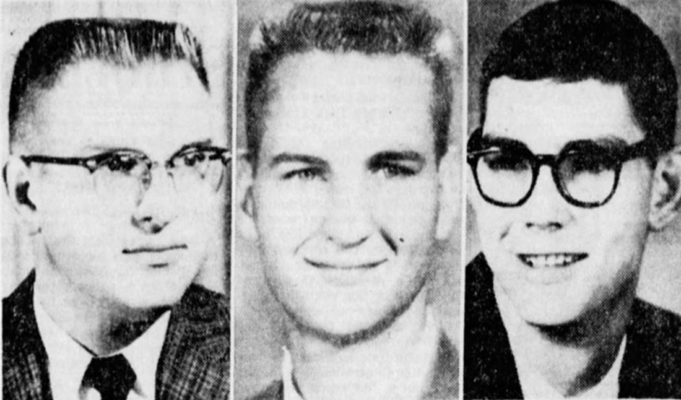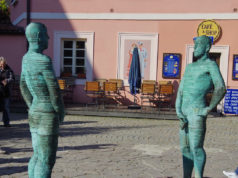The warmer weather this week couldn’t have come at a better time. The Dallas Cowboys are frozen in time. The Texas Lege is run by Neanderthals that reemerged after countless millennia on ice. And Texans these days are about as neighborly as a polar vortex.
But somewhere about now, somebody clever is proffering our favorite cliché: “If you don’t like the weather in Texas, just wait a few minutes. It’ll change.”
Unfortunately, that’s not always a good thing.
On Wednesday, Feb. 3, 1960, Texas Tech University students John P. Arden, Kelton R. Conner Jr., and Robert A. Keplinger left Lubbock and drove 80 miles northeast to collect wildlife specimens and hike in an area then known as the “Caprock,” a long stretch of cliff-like bluffs that divide the high and low plains of the Texas Panhandle.
Arden was a junior architectural engineering major and a member of the Delta Tau Delta fraternity and the West Texas Sports Car Club. He had spent the previous summer vacation working at Yellowstone National Park.
Conner, a Dallas native, was an avid student of biology and zoology. He had made several trips to the region to explore caves and survey the local canyon ecosystem. He was a transfer from Arlington State College (now UTA), where he had been a member of the ROTC program.
Keplinger was a senior engineering major. Arden and Keplinger were from Waxahachie and both members of the same church, Central Presbyterian.
All three young men were 21 years old, healthy, and able-bodied. The weather was mild when they left, and they were looking forward to catching a glimpse of one of the eagles that had been spotted in the area. The Odessa American said Conner had joked with his roommate before heading out.
“If I don’t show up by Thursday,” he said, “call my mother — I’ll be lying dead in a canyon somewhere.”
It was the last words anyone ever heard from them.
Arden, Conner, and Keplinger drove to the edge of the Caprock formation and parked their car near the Lemons Ranch, several miles southeast of Silverton. Then, they hiked into the canyons, went through the slot-canyon formation known as “the Narrows,” and camped in a cave-like shelter near Linguish Falls.
A winter storm surge arrived that night.
When their automobile had remained unattended for three days, locals grew concerned and searched the immediate vicinity. On Saturday, Feb. 8, they found the remnants of the young men’s campfire but no sign of them.
Searchers regrouped at first light Sunday morning with help. A dozen horsemen and two jeeps packed with volunteers (directed by Texas Rangers Capt. Raymond Walters) were joined by a helicopter search team from Reese Air Force Base in Lubbock. They began scouring the area.
Keplinger’s body was found first by Jim Brooks of Silverton. Keplinger had apparently lowered himself into a hole several feet deep to keep warm. His body was discovered in a crouching position, one hand clutching a handkerchief. His last refuge was a short distance just across a canyon from the ranch house of one C.E. Tipton.
Searchers then found Conner’s body a mile and a half to the southeast, just a short distance from the ranch house of John Lemons. Dressed in army fatigues, Conner was lying face down in a gully under a cedar tree, his arms outstretched and one hand clasping a glove and his glasses. Blinded by the snowstorm, he had apparently stumbled off the edge of a high bluff, fallen into the tree, and tumbled to the Caprock floor.
Arden’s body was discovered last, almost 400 feet from Conner’s. He had fallen from a towering limestone cliff into a ravine. He had apparently been knocked unconscious by the fall’s impact and suffered a skull fracture, bruises, lacerations, and loss of blood. One of his tennis shoes was still lying at the top of the cliff.
Searchers gathered up the young men’s remains and transferred them to the Silverton Funeral Home. Silverton resident and Briscoe County Judge J.W. Lyons acted as coroner and ruled that all three deaths had been the result of exposure early on Thursday, Feb. 4.
Investigators concluded that Arden, Conner, and Keplinger had been surprised by the winter surge and then trapped and separated by the accompanying blizzard. Keplinger apparently took unsuccessful shelter. Conner and Arden presumably clambered for help or safety and were whipped and blinded by the lashing snowstorm.
Conner’s joke to Allen turned out to be a premonition.
Cold fronts in Texas (and especially the Panhandle) can come on like a hurricane and drop temperatures 40 degrees in an hour. With winds gusting up to 60 mph, they can leave snowdrifts up to a dozen feet high and kill the majority of unprotected livestock in a county.
Silverton resident Jerry Patton was a senior in high school when the accident occurred and, in 2011, recalled the grim search and commented on its grisly results. “Those boys were ill-prepared for the weather that can happen in this part of the country. Their mistake was unfortunately fatal.”
Conner’s remains were returned to Dallas, and he was buried in Cleburne. The remains of Arden and Keplinger were returned to Waxahachie, where they were laid to rest in separate cemeteries.
The Caprock remained popular with outdoor enthusiasts, and the State of Texas eventually purchased a nearby 15,313-acre parcel of former ranchland and designated it a public recreation area known as Caprock Canyons State Park and Trailway. The park has precautionary measures in place, and folks interested in hiking and camping in backcountry areas must register with park authorities and list their proposed destination and approximate length of stay in case of emergency, weather-related or otherwise.
Panhandle plains, prairielands, pineywoods, Gulf Coast, Rio Grande Valley, Big Bend, or the hill country — it doesn’t matter which way you go. Keep a weather eye. It’s getting weirder by the day.
Fort Worth native E.R. Bills is the bestselling, award-winning author of Texas Obscurities: Stories of the Peculiar, Exceptional and Nefarious.
This column reflects the opinions and fact-gathering of the author(s) and only the author(s) and not the Fort Worth Weekly. To submit a column, please email Editor Anthony Mariani at Anthony@FWWeekly.com. He will gently edit it for clarity and concision.












